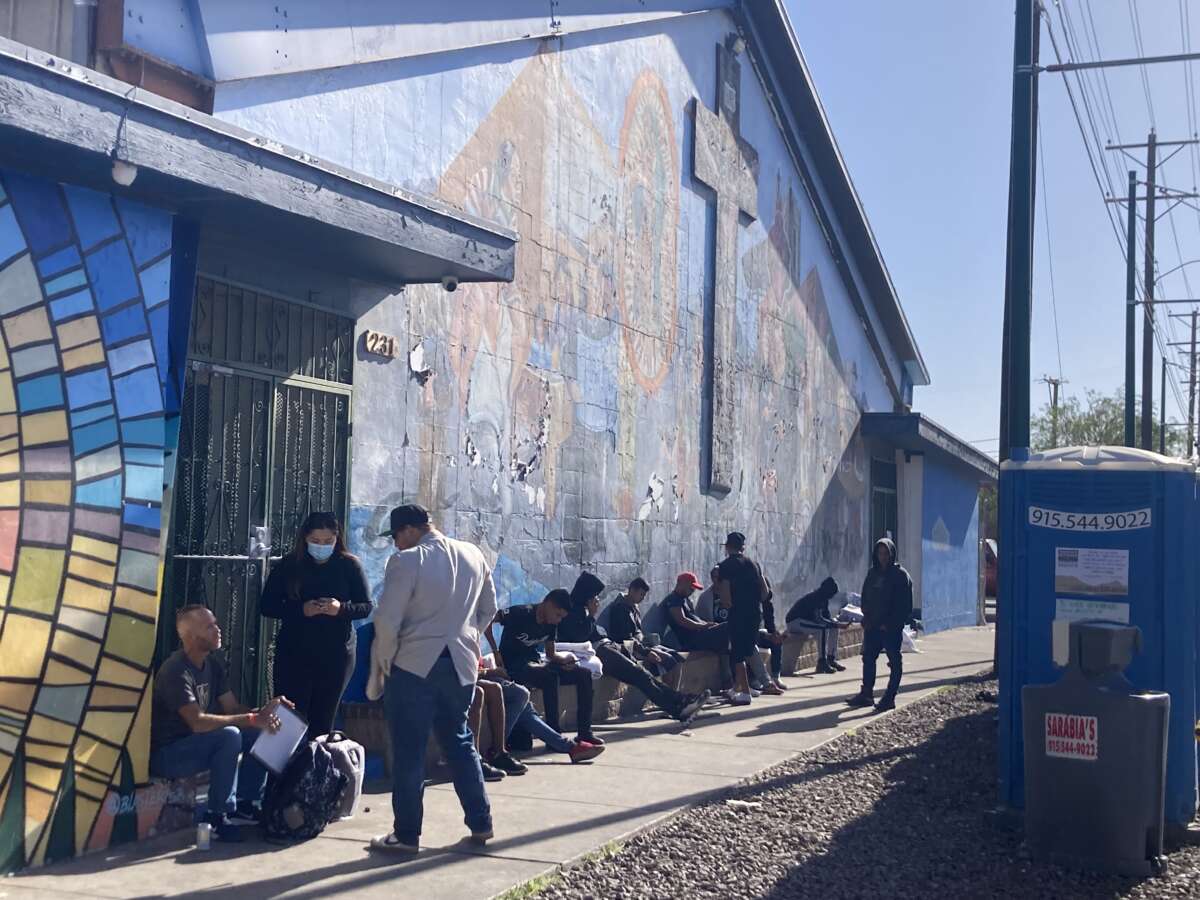El Paso, Texas — Mere blocks from a church where desperate migrants with nothing but the clothes on their backs took refuge under Red Cross-emblazoned blankets, security industry officials in clean-cut suits sipped coffee and complained about the catering at the El Paso Convention Center, where they hawked the latest dystopian tech designed to accelerate brutal repression of migrants.
At the annual Border Security Expo, industry executives and top officials at the Department of Homeland Security discussed Title 42 during the policy’s final hours last week, as well as the Biden administration’s new approach to border enforcement now that the U.S. Customs and Border Protection’s ability to quickly expel migrants under the pandemic-era measure has officially ended.

Border enforcement agents have used Title 42 about 2.7 million times at the southern border since the beginning of the COVID-19 pandemic in March 2020. As the pandemic deepened the crises of poverty and rising gang violence in Central America, agents apprehended undocumented immigrants at the border a record 2.3 million times in fiscal year 2022. Apprehensions have hit 1.2 million so far this fiscal year.
U.S. Border Patrol Chief Raul Ortiz explained during one of the Expo’s opening panels that the transition to processing migrants under an older immigration code, Title 8, was already nearly complete in the run-up to Title 42’s sunset last week, with agents only expelling 17 to 18 percent of migrants under Title 42 in recent months. “As all of America, and the political pundits and the reporters run around saying that when we lose Title 42, the sky’s going to fall — it ain’t gonna fall. We will process that 18, 17 percent via Title 8 processing, as we normally have during my 32-year career,” Ortiz said.

The decades-old Title 8 outlines how migrants are processed at the border, including expedited deportation protocols. The code allows more time for migrants to bring asylum claims than what was allowed under Title 42. Title 8, however, carries stricter penalties, including five- and 10-year bans on reentry for those deported.
On Friday, the Biden administration began seeking to deport migrants who attempt to enter the country without first applying for asylum at new processing centers in nations they travel through along the way, such as Guatemala or Colombia, or through the government app CBP One. The Biden administration has said it will make up to 1,000 appointment slots available each day through the app by means of a semi-random algorithm, but migrants have reported the app is frustratingly slow and glitchy.
Stay in the loop
Never miss the news and analysis you care about.
Immigrant rights advocates say Biden’s asylum transit ban mirrors the Trump administration’s restrictive “Remain in Mexico” program, which forced migrants to wait in Mexico at risk of kidnapping and sexual assault while their U.S. asylum claims were adjudicated. Freedom for Immigrants Policy Director Andrea Carcamo charged Biden with doubling down on the Trump administration’s failed deterrence approach “in place of a humane system that offers life-saving protections to those fleeing persecution.”
The Biden administration deployed 1,500 members of the military to the border last week, joining roughly 2,500 National Guardsmen already deployed there. The recent deployment comes as the Texas Tribune reports Texas House gave final approval to a measure that would create a new state “Border Protection Unit” “independent of the Texas Department of Public Safety and the Texas Military Department” that would be able to arrest, apprehend or detain undocumented migrants.

Acting CBP Deputy Commissioner Benjamine C. Huffman told a Security Expo audience his agency would conduct expedited deportations of single adults under Title 8 and Biden’s new asylum rules “to the maximum extent possible.” Huffman described the administration’s asylum rules as “raising the bar” for what’s known as “credible fear” claims at the border, alleging migrants have been exploiting the asylum process. Meanwhile, CBP El Paso Field Office Operations Director Hector Mancha said the agency expects processing under Title 8 to decrease repeat undocumented border crossings over time due to Title 8’s harsher penalties.

The “Great Eye”
More than 1,700 DHS and industry officials pushed for the deployment of more militarized technology at the border during the two-day Security Expo, the nation’s premier event for border security contracting. Talks focused on how best to procure new technologies and accelerate the bipartisan buildout of a digital “smart” wall powered by biometric data, artificial intelligence, facial recognition, aerial drones, infrared cameras, motion sensors, license plate-readers, radar, vehicle-mounted mobile surveillance — and now, the CBP One app.
The Biden administration’s strategy of an AI-powered smart wall and efforts to fill in gaps left in Trump’s physical border wall in places like Arizona, compounds Texas Gov. Greg Abbott’s state-funded effort to finish the wall, as South Texas residents in Webb and Zapata Counties face new contracts for border barriers they say will destroy their riverfront communities.
“I want my [border] checkpoints to be state of the art. I want our processing facilities to be run like Chick-fil-A’s. I want crisis management to be our preparedness plan, and not our everyday mandate for operations. And then I want our intelligence enterprise to be second to none,” Border Patrol Chief Ortiz said during the Expo’s “State of the Border” panel last week.

Dystopian border security technologies were on full display in the Expo’s exhibit hall: robotic dogs, motion sensors, the latest drone and Taser technologies, new bullet-proof armor, and surveillance and thermal-imaging cameras of every shape and size. Vendors advertised their wares to an agency with a $175.3 billion annual budget as “mission critical communications,” “solutions made for all domains,” “ruggedized robots,” and “video and data at the tactical edge.”
The crown jewel of the display room, however, was defense technology startup Anduril’s solar-powered “autonomous surveillance towers.” The towers combine with Google Cloud technology to facilitate the use of artificial intelligence by the CBP Innovation Team, known as INVNT. The towers’ AI system, called Lattice, can autonomously track humans or vehicles up to 2.8 kilometers away.

Anduril, the Expo’s main sponsor this year, was founded by Palmer Luckey, who has close ties to mass surveillance firm Palantir, named for the magical seeing-stones in J.R.R. Tolkien’s Lord of the Rings. Venture capitalist Peter Thiel, who maintains close ties to former Trump administration officials, invests in both Palantir and Anduril through the Founders Fund venture capital firm. CBP has awarded Anduril a contract to deploy at least 189 towers along the southwest border. Moreover, Anduril has already received more than $60 million in DHS contracts, including for pilot programs working to test pattern-recognition software and laser-equipped cameras at the border.
Luckey followed Thiel’s lead in naming his company after a magical object from the Lord of the Rings, opting for the hero Aragorn’s reforged sword as its namesake. But standing in front of the company’s surveillance tower, displayed proudly at the front of exhibit hall, it’s hard to mistake it for anything other than the real-world incarnation of the evil, all-seeing Eye of Sauron, whose lidless gaze, powered by thermal-imaging and radar, does indeed pierce “cloud, shadow, earth, and flesh.”
Sanctuary at Sacred Heart
Less than half a mile away, outside the Sacred Heart Church, you can see the alleged “threat” requiring “force multipliers” like robot dogs and thermal eyes that government and industry officials kept referring to repeatedly during the conference: fewer than 200 migrants, some kicking around a soccer ball or juggling clementines, while most leaned against the church’s alleyway trying desperately to figure out their next move.

Many attached blankets to the walls and fences surrounding the church, forming makeshift lean-tos and sleeping on cardboard pallets beneath them. At most, migrants had a backpack and extra change of clothes. I watched as city workers conducted a sweep of the area, trashing blankets and plastic water bottles that littered the area in a Sisyphean attempt to mitigate the squalor migrants have been forced to endure for days on end. El Paso police officers occasionally circled the area on bicycles. The only “border crisis” here continues to be humanitarian one.

Most of those still at the church by the time I arrived had surrendered to border enforcement agents after a federal raid earlier in the week had cleared an estimated 2,000 migrants who previously sought sanctuary at the downtown church and the El Paso Opportunity Center for the Homeless. Agents dropped off flyers in Spanish encouraging migrants to turn themselves in at a nearby Border Patrol station for processing in exchange for documents allowing them to travel or be sheltered in El Paso.
According to CBP officials, 917 people surrendered over two days last week and agents apprehended another 44 migrants in a second phase of the “targeted enforcement operation.” A majority of those who turned themselves in were processed for release with a “Notice to Appear” at an immigration hearing. Many of the migrants I saw at Sacred Heart had manilla folders containing their documents among their few possessions.
El Paso Mayor Oscar Leeser, kicking off the Expo on May 10, told the audience that, “Two days ago we had 2,500-3,000 people sleeping at Sacred Heart; we reached out and asked for support [from CBP], and we got the support we needed, and we see the numbers are going down.” Leeser issued a state of emergency for El Paso that went into effect on May 1. It was the second disaster declaration he’s issued since December, when Border Patrol dropped migrants off on the streets in frigid temperatures.

Among the organizations set up at the church to provide assistance was the El Paso-based Border Network for Human Rights, which set up a “know your rights” information booth outside the church. Network Communication Coordinator Alan Lizárraga told Truthout that staffers were working to inform migrants about the protocols under Title 8 and Biden’s new asylum rules ahead of Title 42’s sunset last week.
“The border has never been as militarized as it is right now. We have the state government sending troops here, the National Guard. We also have state troopers at the border. We just got additional troops from President Biden,” Lizárraga said. “We obviously feel over-policed here in El Paso…. I think the Border Expo shows … that instead of creating welcoming infrastructure, instead of creating actual policies that would aid toward a more humane, more practical immigration system, we’re getting Border Protection Units, we’re getting military personnel, we’re getting more police more agents.”
“Instead of creating welcoming infrastructure, instead of creating actual policies that would aid toward a more humane, more practical immigration system, we’re getting Border Protection Units, we’re getting military personnel, we’re getting more police more agents.”
Lizárraga helped translate for Esteban, who wanted to be identified only by his first name for fear of persecution. He said he traveled through the perilous rainforest of the Darién Gap in Central America to flee the devastating poverty in his country of origin in Venezuela. Esteban said he spent 10 months traveling before crossing between the ports of entry into the U.S. and making his way to Sacred Heart, where he’d been staying for a week at that point. He held up his manilla folder, explaining that he turned himself in the day before and was processed with a notice to appear at an immigration court in Las Vegas, where he has family. He was waiting for relatives to send him money to make the trip.
Esteban said he hoped to be able to work and contribute to the U.S. economy so that he could send money back to his two children in Peru and Venezuela, as well as his mother, who is ill. He said he lost friends to the deadly fire at the Mexican-run detention center where 40 migrants died in Ciudad Juárez in March, and that he and many of the migrants here at the church have suffered great loss just to make the journey to the U.S. The migrant community outside the church, he said, see themselves as a family and have been sharing resources and supporting each other.
As Title 42 ended last week, El Paso Mayor Leeser told reporters Friday that, while the city had prepared for a massive influx of migrants by converting two vacant middle schools into temporary shelters, there were no major issues as the policy expired Thursday night. “A top Biden administration official added Friday that there was no ‘major influx’ of migrants rushing to the southern border overnight,” according to the Texas Tribune.
Press freedom is under attack
As Trump cracks down on political speech, independent media is increasingly necessary.
Truthout produces reporting you won’t see in the mainstream: journalism from the frontlines of global conflict, interviews with grassroots movement leaders, high-quality legal analysis and more.
Our work is possible thanks to reader support. Help Truthout catalyze change and social justice — make a tax-deductible monthly or one-time donation today.
